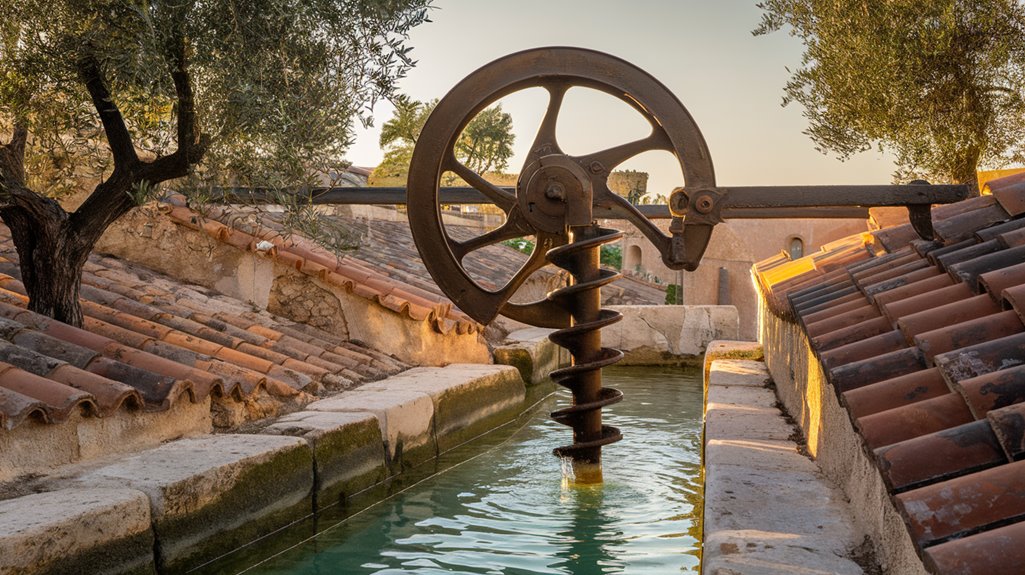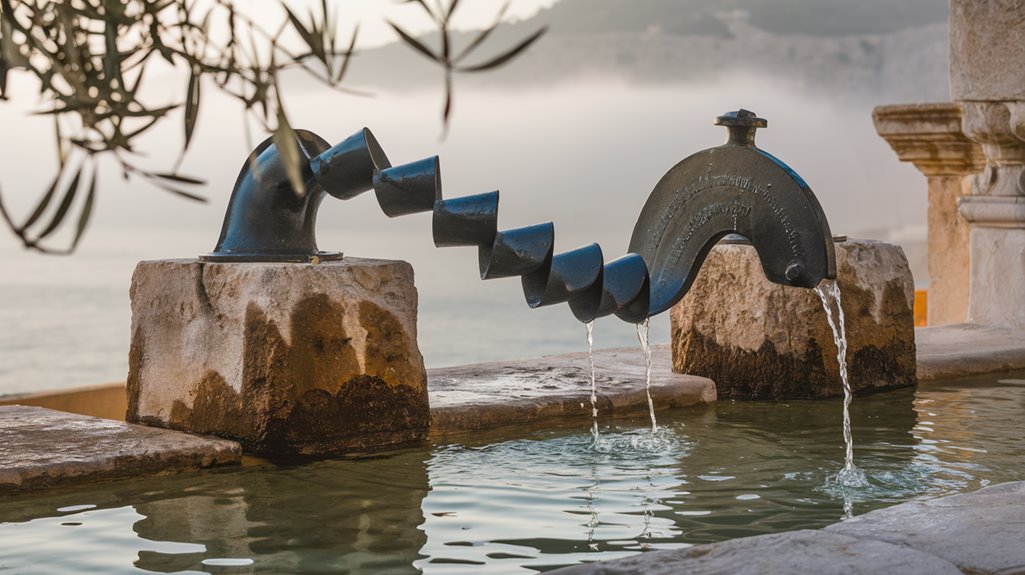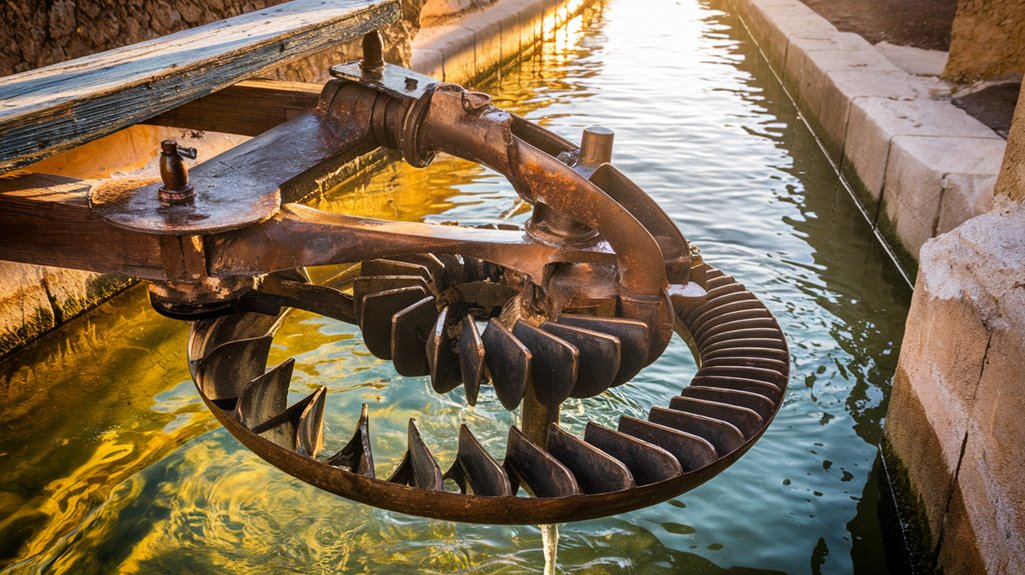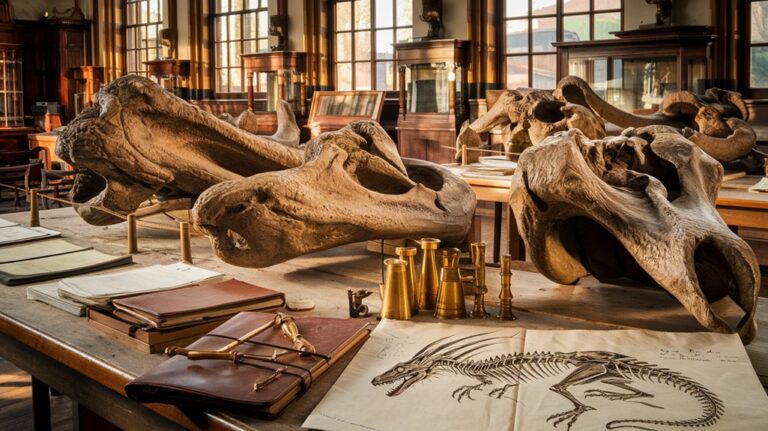Archimedes’ Water Screw: An Ancient Engineering Marvel
Like a spiral staircase lifting droplets skyward, the Archimedes' Water Screw stands as one of humanity's most elegant solutions to a basic problem. You'll find this ancient device's influence stretching from the fertile banks of the Nile to today's modern water treatment facilities. While you might recognize Archimedes' name attached to this invention, there's more to the story of how this deceptively simple machine transformed civilization and continues to shape our approach to water management.
The Origins and Discovery of the Ancient Water Screw

While many attribute the water screw's invention to Archimedes in the 3rd century BC, archaeological evidence suggests its origins trace back even further to ancient Egypt and Mesopotamia. Among the most significant Ancient Innovations, bronze casting evidence and cuneiform inscriptions point to the device's use in the Neo-Assyrian Empire as early as the 7th century BC. The mechanism's simple helical design made it an incredibly effective tool for water displacement.
You'll find that Water Management played a vital role in these civilizations, with the screw being used for irrigation, dewatering ships, and land drainage. The device proved especially valuable as it could empty flooded mines efficiently.
While Archimedes didn't invent the water screw, he's credited with enhancing its design and providing mathematical explanations for its operation. One theory suggests he independently developed the device to help King Hiero remove water from ship hulls, showcasing how ancient engineers often arrived at similar solutions to common problems.
How the Archimedes Screw Works: Design and Mechanics
The Archimedes screw combines elegant simplicity with mechanical brilliance in its design. At its core, you'll find a central cylindrical shaft wrapped with a helical surface, all housed within a hollow pipe. The design's success relies on having side walls attached to prevent water from escaping during operation.
The design efficiency comes from its 45-degree inclination and ability to lift water through rotation, whether powered by wind, animals, or motors. This innovation revolutionized water lifting when Konrad Kyeser introduced the crank mechanism in 1405.
When you examine its mechanical advantages, you'll notice that perfect sealing isn't necessary – any water leaking from one section gets caught by the next spiral turn.
The device's versatility shows in its material options, from wood strips to bronze sheeting. You can even reverse its operation, turning it from a pump into a generator.
Modern applications demonstrate its enduring value, from wastewater treatment to hydroelectric power generation, handling flow rates from 0.01 to 14.5 cubic meters per second.
Historical Impact on Agriculture and Mining
Since its ancient origins, Archimedes' screw transformed agriculture and mining through revolutionary water management capabilities.
You'll find its impact most evident in agricultural sustainability, where it enabled irrigation of previously unusable lands and supported farming in drought-prone regions. This reliable technology proves especially vital when river levels drop during dry seasons. From ancient Babylon to Egypt, the device helped civilizations thrive by raising water to higher ground efficiently.
In mining operations, you'll see how this innovation dramatically improved efficiency by removing water from deep mines and low-lying areas. The Romans particularly benefited from this technology in their Spanish mines. Today, this ancient technology is being adapted to protect communities, as demonstrated by new facilities utilizing six giant screws to combat devastating floods.
What's remarkable is that the screw's simple yet effective design continues to influence modern practices. It's a proof of ancient engineering that demonstrates how sustainable solutions can endure through millennia, inspiring today's water management technologies.
From Ancient Egypt to Modern Applications
Originally developed for irrigation in ancient Egypt, Archimedes' screw has evolved far beyond its humble beginnings to find diverse applications worldwide.
The device's rotating helical design enables efficient water movement through a hollow pipe. These ancient innovations continue to shape modern engineering, from wastewater treatment to sustainable energy production.
You'll find these engineering principles at work in numerous contemporary settings. The device now powers small-scale hydroelectric projects, moves grain in agricultural equipment, and even helped stabilize the Leaning Tower of Pisa. The SS Archimedes made history as the first steamship to use this technology for marine propulsion in 1839.
Its eco-friendly design makes it particularly valuable for sustainable development, as it requires minimal energy while maintaining high efficiency.
When you consider that a 15th-century German engineer's addition of a crank mechanism has led to modern applications in injection molding and waste compacting, you'll appreciate how this ancient Egyptian technology remains remarkably relevant today.
Engineering Legacy and Sustainable Solutions

Representing one of history's most enduring engineering marvels, Archimedes' screw continues to shape sustainable solutions across diverse industries today. The helical tube design enables continuous flow with minimal mechanical effort.
You'll find this remarkable device exemplifying timeless engineering principles in modern applications, from wastewater treatment to renewable energy generation. Originally designed to address water elevation challenges, this ancient invention has proven invaluable across millennia. Its eco-friendly design and minimal energy requirements make it a prime example of sustainable technology that's as relevant now as it was in ancient times.
- Powers hydroelectric systems in low-head sites where traditional turbines can't operate effectively
- Provides fish-friendly water management solutions due to its slow rotation speed
- Handles varying flow rates and suspended solids in wastewater treatment
- Inspires modern innovations in snow blowers, grain elevators, and chocolate fountains
- Demonstrates how ancient ingenuity can address contemporary environmental challenges










